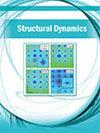The Integrated Resource for Reproducibility in Macromolecular Crystallography: Experiences of the first four years
IF 2.3
2区 物理与天体物理
Q3 CHEMISTRY, PHYSICAL
引用次数: 21
Abstract
It has been increasingly recognized that preservation and public accessibility of primary experimental data are cornerstones necessary for the reproducibility of empirical sciences. In the field of molecular crystallography, many journals now recommend that authors of manuscripts presenting a new crystal structure should deposit their primary experimental data (X-ray diffraction images) to one of the dedicated resources created in recent years. Here, we describe our experiences developing the Integrated Resource for Reproducibility in Molecular Crystallography (IRRMC) and describe several examples of a crucial role that diffraction data can play in improving previously determined protein structures. In its first four years, several hundred crystallographers have deposited data from over 5200 diffraction experiments performed at over 60 different synchrotron beamlines or home sources all over the world. In addition to improving the resource and curating submitted data, we have been building a pipeline for extraction or, in some cases, reconstruction of the metadata necessary for seamless automated processing. Preliminary analysis indicates that about 95% of the archived data can be automatically reprocessed. A high rate of reprocessing success shows the feasibility of using the automated metadata extraction and automated processing as a validation step for the deposition of raw diffraction images. The IRRMC is guided by the Findable, Accessible, Interoperable, and Reusable data management principles.大分子晶体学再现性的综合资源:前四年的经验
人们越来越认识到,原始实验数据的保存和公众获取是经验科学再现性所必需的基石。在分子晶体学领域,许多期刊现在建议,呈现新晶体结构的手稿的作者应该将他们的主要实验数据(X射线衍射图像)保存到近年来创建的专用资源中。在这里,我们描述了我们开发分子晶体学再现性综合资源(IRRMC)的经验,并描述了衍射数据在改善先前确定的蛋白质结构方面可以发挥关键作用的几个例子。在最初的四年里,数百名晶体学工作者已经保存了来自世界各地60多个不同同步加速器束线或家庭源进行的5200多个衍射实验的数据。除了改进资源和管理提交的数据外,我们还一直在构建一个管道,用于提取或在某些情况下重建无缝自动化处理所需的元数据。初步分析表明,大约95%的存档数据可以自动重新处理。高的再处理成功率表明了使用自动元数据提取和自动处理作为沉积原始衍射图像的验证步骤的可行性。IRRMC遵循可查找、可访问、可互操作和可重复使用的数据管理原则。
本文章由计算机程序翻译,如有差异,请以英文原文为准。
求助全文
约1分钟内获得全文
求助全文
来源期刊

Structural Dynamics-Us
CHEMISTRY, PHYSICALPHYSICS, ATOMIC, MOLECU-PHYSICS, ATOMIC, MOLECULAR & CHEMICAL
CiteScore
5.50
自引率
3.60%
发文量
24
审稿时长
16 weeks
期刊介绍:
Structural Dynamics focuses on the recent developments in experimental and theoretical methods and techniques that allow a visualization of the electronic and geometric structural changes in real time of chemical, biological, and condensed-matter systems. The community of scientists and engineers working on structural dynamics in such diverse systems often use similar instrumentation and methods.
The journal welcomes articles dealing with fundamental problems of electronic and structural dynamics that are tackled by new methods, such as:
Time-resolved X-ray and electron diffraction and scattering,
Coherent diffractive imaging,
Time-resolved X-ray spectroscopies (absorption, emission, resonant inelastic scattering, etc.),
Time-resolved electron energy loss spectroscopy (EELS) and electron microscopy,
Time-resolved photoelectron spectroscopies (UPS, XPS, ARPES, etc.),
Multidimensional spectroscopies in the infrared, the visible and the ultraviolet,
Nonlinear spectroscopies in the VUV, the soft and the hard X-ray domains,
Theory and computational methods and algorithms for the analysis and description of structuraldynamics and their associated experimental signals.
These new methods are enabled by new instrumentation, such as:
X-ray free electron lasers, which provide flux, coherence, and time resolution,
New sources of ultrashort electron pulses,
New sources of ultrashort vacuum ultraviolet (VUV) to hard X-ray pulses, such as high-harmonic generation (HHG) sources or plasma-based sources,
New sources of ultrashort infrared and terahertz (THz) radiation,
New detectors for X-rays and electrons,
New sample handling and delivery schemes,
New computational capabilities.
 求助内容:
求助内容: 应助结果提醒方式:
应助结果提醒方式:


